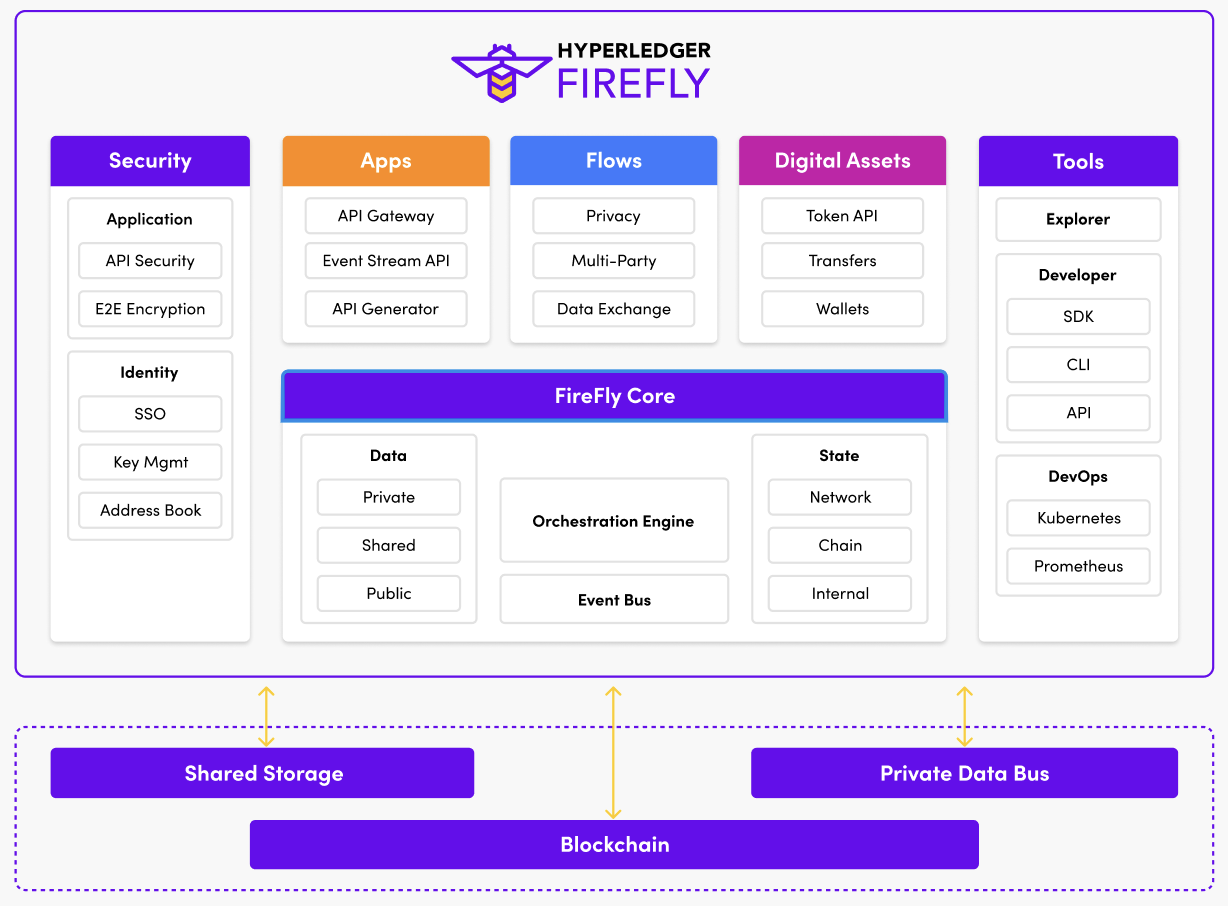Hyperledger FireFly V1.1 Is Now Available

Before Hyperledger FireFly, blockchain developers spent a lot of time building the plumbing of their application. They built complex middleware components from scratch. Hyperledger FireFly was a sea change. The first open source Supernode, Hyperledger FireFly offers developers a complete stack to build and scale secure web3 applications.

Hyperledger FireFly accelerates development with a rich stack of native web3, B2B, and integration services. It simplifies the deployment and management of many apps via a single console, and offers a new tool to connect to the multi-chain and multi-protocol web3 world.
This is more important than ever as public and private chain use cases intermingle more and more in novel enterprise applications. That’s what makes the new release of Hyperledger FireFly exciting. Developments to the stack make it radically simple for developers to launch production-ready apps on both public and private chains and manage multiple applications from a single console with multi-tenant support, plugin flexibility, and pluggable security.
Introducing Web3 Gateway Mode
Hyperledger FireFly can now operate in two modes. The first is familiar to current users of the stack. Consortium Mode is used to build consortiums or multi-party business networks where data needs to be agreed to and shared among the group. Use cases for Consortium Mode have included healthcare and insurance consortiums, supply chain participants, financial networks, and other examples where companies come together to streamline how they do business.
This release introduces the new Web3 Gateway Mode. Gateway Mode is used when the main goal of the Supernode is to connect to a public blockchain. Where previously developers could use a public tether to access popular public chains, this new mode acts as a doorway into the full world of web3 with support for popular public chains including Ethereum, Polygon, Avalanche, Optimism, BNB Chain, Arbitrum, Moonbeam, Fantom and more.
The worlds of public and private blockchain are merging. Enterprises are eager to tap into the reach, security, and decentralization of public chains. At the same time, public chain players are looking to optimize throughput, scalability, and gas fees in ways that have long been familiar to enterprise networks. This release of Hyperledger FireFly offers a stack to build for both worlds.

Public Blockchain Support
Along with the ability to connect across public chains, Hyperledger FireFly 1.1 has new tools and support to simplify public use cases for the enterprise.
- FireFly Transaction Manager, an all new EVM Connector, handles the complex concerns of public chains, including gas estimation, resubmission policies, and more.
- FireFly Signer can be used for transaction signing in networks where it is necessary to separate private keys from the blockchain node.
- Enhanced Gateway Support makes it easy to keep private data private, while interacting with public chains.
Hyperleger FireFly 1.1 allows developers to access both public and private chains simultaneously, while building in guardrails specific to the enterprise space, ensuring new applications meet both user and compliance requirements.
Multi-tenant Support
Hyperledger FireFly 1.1 adds namespace isolation for segregating data and operations. Inside the Supernode, each namespace is an isolated environment within a FireFly runtime. This allows independent configuration of plugin and infrastructure components, API security, identity broadcasting, on-chain data indexing, and management of how data should be shared.
Namespaces work in both modes. Consortium Namespaces can be used when multiple parties need to share on- and off-chain data and agree upon the ordering and authenticity of that data. While Web3 Gateway Namespaces are available when interacting directly with a blockchain, without assuming that the interaction needs to conform to FireFly’s multi-party system model.
A single FireFly node can run multiple namespaces in either mode at the same time. This lets developers build flows that coordinate between public chains and private consortiums. The diagram below illustrates the visibility and control available to an organization as they run multiple applications from a single console, each segregated to meet security requirements.

Multiple Instances of Plugins
With the new release, a single FireFly node can now use several instances of each type of plugin that is available. As we illustrated above, we’re connecting to multiple blockchains simultaneously, often for different use cases or goals. The ability to run different plugins in each namespace means a developer has greater agility to coordinate flows for each chain or consortium.
Pluggable API Security
The flexibility to connect to multiple applications and multiple chains is only valuable in the enterprise space if it can be matched with the appropriate security, both for the integrity of the network and for compliance standards.
With Hyperledger FireFly 1.1, API Security can be enabled at several levels. This includes on any service or on a specific namespace.
With two different modes of operation, tenant isolation, flexibility of plugins, and tailored security at any level, the ability of a developer to deploy and manage applications with the right functionality and permissioned access is greatly increased.
The Next-gen Platform
Hyperledger FireFly v1.0 was a welcomed addition to the blockchain developer’s toolkit. It brought to blockchain the convenience of a rich middleware stack common in the Web 2.0 space.
With the new release, Hyperledger FireFly is positioning enterprises to harness the benefits of both public and private blockchain technologies. It gives developers the ability to quickly launch multiple applications, tailor each to the desired business logic and security requirements—all while providing a gateway into the wider world of web3.
Hyperledger FireFly 1.1 is another step toward bringing the Enterprise closer to realizing the full potential of web3—both with permissioned chains and connections to public ecosystems. If that’s something you’re interested in, we invite you to come be part of our community. You can learn more in the FireFly docs and download the CLI on the FireFly Github. If you have any questions, find us in the FireFly channel on the Hyperledger Discord.
